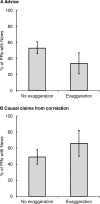Exaggerations and Caveats in Press Releases and Health-Related Science News
- PMID: 27978540
- PMCID: PMC5158314
- DOI: 10.1371/journal.pone.0168217
Exaggerations and Caveats in Press Releases and Health-Related Science News
Abstract
Background: Exaggerated or simplistic news is often blamed for adversely influencing public health. However, recent findings suggested many exaggerations were already present in university press releases, which scientists approve. Surprisingly, these exaggerations were not associated with more news coverage. Here we test whether these two controversial results also arise in press releases from prominent science and medical journals. We then investigate the influence of mitigating caveats in press releases, to test assumptions that caveats harm news interest or are ignored.
Methods and findings: Using quantitative content analysis, we analyzed press releases (N = 534) on biomedical and health-related science issued by leading peer-reviewed journals. We similarly analysed the associated peer-reviewed papers (N = 534) and news stories (N = 582). Main outcome measures were advice to readers and causal statements drawn from correlational research. Exaggerations in press releases predicted exaggerations in news (odds ratios 2.4 and 10.9, 95% CIs 1.3 to 4.5 and 3.9 to 30.1) but were not associated with increased news coverage, consistent with previous findings. Combining datasets from universities and journals (996 press releases, 1250 news), we found that when caveats appeared in press releases there was no reduction in journalistic uptake, but there was a clear increase in caveats in news (odds ratios 9.6 and 9.5 for caveats for advice and causal claims, CIs 4.1 to 24.3 and 6.0 to 15.2). The main study limitation is its retrospective correlational nature.
Conclusions: For health and science news directly inspired by press releases, the main source of both exaggerations and caveats appears to be the press release itself. However we find no evidence that exaggerations increase, or caveats decrease, the likelihood of news coverage. These findings should be encouraging for press officers and scientists who wish to minimise exaggeration and include caveats in their press releases.
Conflict of interest statement
The authors have declared that no competing interests exist.
Figures




References
-
- Gandy OH. Beyond agenda setting Ablex Publishing Corporation; 1982.
-
- Nelkin D. Selling Science. W H Freeman & Company; 1995.
-
- Williams A. Environmental news journalism, public relations, and news sources. hansen A, Cox R, editors. 2015. pp. 197–206.
-
- Lewis J, Williams A, Franklin B. A compromised fourth estate? Journalism Studies. 2008;9: 1–20.
-
- Bauer MW, Bucchi M. Journalism, Science and Society. Routledge; 2008.
MeSH terms
LinkOut - more resources
Full Text Sources
Other Literature Sources

